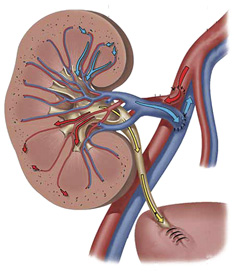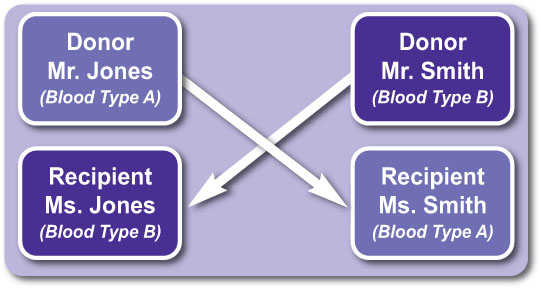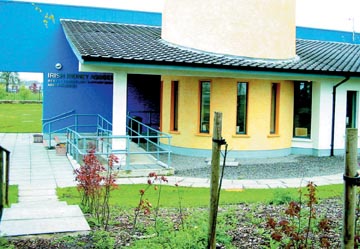
If you are interested in becoming a living kidney donor and are in good health, here are some steps you can take. More details
 THE RECIPIENT’S TRANSPLANT
THE RECIPIENT’S TRANSPLANTThe kidney is put into the outer pelvis – protected by the hip bone – low down and to one side of the bladder. The blood vessels of the kidney are joined to the large blood vessels supplying the leg. The kidney lies here away from the intestines and their covering and the ureter can more easily be sewn into the bladder.
The recipient should be out of bed within a day or two. After only a few days, most or all of the tubes will be
removed. Medicines to suppress the immune system will be necessary. These drugs help the recipient’s body to tolerate a ‘foreign’ organ. In the early stages, the medication may be in the form of infusions. Later this will change to tablets. This medication will have to be taken, by the recipient, for the entire life of the transplanted kidney.
The most anxious time for both donor and recipient is the wait to see if the new kidney functions well. Depending on how successful the transplant has been, the recipient can expect to leave hospital between one and three weeks post-surgery. By this time, he/she will usually be feeling the benefit of the kidney transplant. Initially, recipients will have to be seen quite frequently in the out patients’ clinic but this becomes less frequent as time progresses.
If you are not a match for the recipient because of blood group or antibody reasons there are a number of possibilities. If the recipient is not highly sensitised (PGEN<70%) and has a blood group incompatible donor, the best option to consider would be to enter into a paired kidney exchange. That is where the patient’s donor gives his kidney to a compatible recipient and another donor gives a kidney to our patient.
An example could be a brother who wants to donate a kidney to his sister but is unable to because of a difference in blood type. If this recipient/donor pair consents to participate in the paired kidney exchange programme, an attempt would be made to match them with another recipient/donor in the same situation willing to "exchange" kidneys. An example is if Mr. Jones who is blood type A wants to donate a kidney to Ms. Jones who is blood type B and another donorrecipient pair, Mr. and Mrs. Smith, have the opposite circumstance (blood type B donor who wants to donate to blood type A recipient). The donor kidney could be exchanged and both groups would undergo transplant procedure which would not otherwise happen.

Blood Type Matching
IT IS IMPORTANT TO POINT OUT THAT SUCH AN ARRANGEMENT IS NOT YET AVAILABLE IN IRELAND BUT YOUR TRANSPLANT TEAM MIGHT BE ABLE TO ARRANGE FOR YOU TO BE REFERRED TO THE UK, WHERE SUCH PROCEDURES HAVE TAKEN PLACE.
If the recipient is highly sensitised (PGEN>70%) and they have an ABO incompatible donor but well HLA-matched donor, it might be possible to enter into a programme to remove the recipient’s ABO antibodies and proceed ahead with the kidney transplant.
 SUMMARY OF TESTS INVOLVED
SUMMARY OF TESTS INVOLVEDA sequence of tests are necessary to thoroughly examine the health of the potential living donor and the function and anatomy of the donor kidney. A potential living donor can expect:
| Summary of Test Involved |
|
|---|---|
| Test | Purpose |
| Blood Pressure | Excludes high blood pressure. |
| Urine Analysis | Identifies any underlying conditions. |
| Blood Tests | For routine analyses. Another blood test will be taken from both the potential recipient to check the recipient does not have antibodies which may react to the donor. This test will be repeated just before the operation. |
| Creatinine clearance | If the kidneys are not functioning well, the creatinine level rises. By measuring the creatinine and the amount being excreted in the urine, a more precise assessment of kidney function can be made. |
| X-rays | Ensures normal function, especially of the chest area. |
| ECG | A cardiograph of the heart function is recorded to exclude heart disease. |
| GFR | Assesses the capability of the donor kidney to ‘clear’ the blood of a toxic substance. |
| Ultrasound | Checks the size and shape of the kidneys and excludes any anatomical abnormalities. |
| KUB | X-ray of kidneys. |
| Spiral CT Scan | Looks in detail at the kidneys and look and blood vessels going to the kidneys. After this test, the surgeon will discuss with the donor which kidney is recommended for removal. |
 The Irish Kidney Association Renal Support Centre has been in operation since 2000. The Centre, located in the grounds of Beaumont Hospital, just 100 metres walk from the main hospital entrance, is open all year round and provides free accommodation for all its residents, who include:
The Irish Kidney Association Renal Support Centre has been in operation since 2000. The Centre, located in the grounds of Beaumont Hospital, just 100 metres walk from the main hospital entrance, is open all year round and provides free accommodation for all its residents, who include:
 FACILITIES
FACILITIESTen en-suite bedrooms which can sleep up to four persons. All rooms are on ground floor level. All rooms have TV. All rooms are in direct contact to and from the hospital ward by telephone. Comfortable sittingroom/day room with satellite TV and video. Small library. Fully fitted kitchen where meals can be prepared by residents. Tea and coffee is provided for residents and guests. Laundry room with washing powder supplied. Ironing facilities are also available. Parking for overnight residents only. The Renal Support Centre is owned and funded by the Irish Kidney Association. Donations from
residents and fundraising initiatives are most welcome.
The Centre is open to residents all year round. Day facilities are available Monday to Friday from 8.30am to 4.30pm, Saturday and Sunday 12pm-4pm.